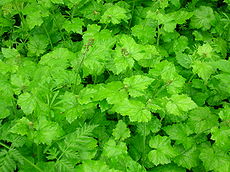
Tolmiea
Encyclopedia

The plant has unusual reproductive habits. It grows plantlets from the petiole
Petiole (botany)
In botany, the petiole is the stalk attaching the leaf blade to the stem. The petiole usually has the same internal structure as the stem. Outgrowths appearing on each side of the petiole are called stipules. Leaves lacking a petiole are called sessile, or clasping when they partly surround the...
near the base of each leaf. The plantlets drop off, fall in the soil, and take root there. It will also reproduce by rhizome
Rhizome
In botany and dendrology, a rhizome is a characteristically horizontal stem of a plant that is usually found underground, often sending out roots and shoots from its nodes...
and by seed propagation. It bears small flowers of various colors, usually brownish-purple to white depending on the cultivar. It has hairy, toothed leaves and a capsule fruit containing spiny seed.
The plant is also unusual in that it is sometimes diploid and sometimes tetraploid, due to autopolyploidy
Polyploidy
Polyploid is a term used to describe cells and organisms containing more than two paired sets of chromosomes. Most eukaryotic species are diploid, meaning they have two sets of chromosomes — one set inherited from each parent. However polyploidy is found in some organisms and is especially common...
.
The genus was named after the Scottish-Canadian botanist William Fraser Tolmie
William Fraser Tolmie
William Fraser Tolmie was a Canadian surgeon, fur trader, scientist, and politician....
while the species name refers to Archibald Menzies
Archibald Menzies
Archibald Menzies was a Scottish surgeon, botanist and naturalist.- Life and career :Menzies was born at Easter Stix in the parish of Weem, in Perthshire. While working with his elder brother William at the Royal Botanic Gardens, he drew the attention of Dr John Hope, professor of botany at...
the Scottish naturalist for the Vancouver Expedition
Vancouver Expedition
The Vancouver Expedition was a four-and-a-half-year voyage of exploration and diplomacy, commanded by Captain George Vancouver. The expedition circumnavigated the globe, touched five continents and changed the course of history for the indigenous nations and several European empires and their...
(1791-1795).

